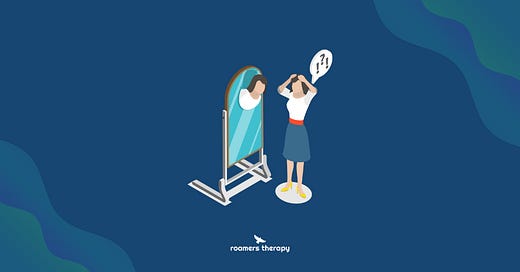Stigma refers to the disgust, disgrace, or disapproval of a quality or group of people. Stigma is often formed by our biases.
Biases are unconscious beliefs or attitudes about people or things. They are shaped by society, culture, upbringing, experiences, and relationships.
Stigma can include harmful beliefs about people based on gender, race, sexuality, religion, nationality, appearance, age, abilities, and many other identities.
What is Internalized Stigma?
Internalized stigma refers to negative beliefs or biases towards our identities.
Examples of internalized stigma include:
Feelings of shame around specific identities
Beliefs about superiority for presenting or behaving like others from your cultural group
Feelings of inadequacy due to illness or disability
Favoring people, media, or ideals of the dominant culture.
Why Do We Experience Internalized Stigma?
There are many reasons we might hold beliefs that are internally stigmatizing, and for some, there can be more than one factor. Here are some examples:
Having negative views about specific identities instilled in you
Wanting to assimilate into the dominant culture
Being taught that your identity is wrong, dangerous, or inadequate
Seeking acceptance from members of the dominant culture or members of our immediate community
Feeling fear about embracing your stigmatized identity
How Does Internalized Stigma Affect Us?
Holding internalized stigma towards our identities can be harmful to ourselves and our loved ones.
When we hold negative attitudes towards ourselves, we can alienate ourselves from the people and communities we love the most.
Additionally, we can become depressed due to hiding, resenting, or feeling shame about some of the most important parts of ourselves.
We may also feel lonely due to feeling living inauthentically.
How Can I Challenge My Internalized Stigma?
Internalized stigma or shame can be difficult to live with. Fortunately, these beliefs are malleable, meaning they can change (even if they have been around for a long time!).
Challenging these beliefs is the process of 1) unlearning much of the harmful information instilled in you and 2) learning to love the things about yourself that make you who you are.
Reflection Exercise
If you are working to unlearn some of your biases, this reflection exercise:
What are some biases you are aware of?
Are there any blind spots (or deeper biases that might not be so front of mind)?
Where did these biases come from?
How do these thoughts benefit you?
How do they not benefit you?
What do you need to let go of?
What do you need to learn?
How different would your life be if you did not have these beliefs?
Additional Exercises
In addition to reflecting on your biases and internalized stigma, you can challenge these beliefs in many other ways. Some examples include:
Creating a safe space to discuss your beliefs (like therapy)
Immersing yourself in the culture or community, you hold these beliefs about
Consuming diverse forms of media for these cultures, identities, or communities
Becoming an ally or advocate for these cultures, identities, or communities.
Takeaways
We all have biases (even about our own communities, culture, or identities). Having biases is not a bigger problem. It’s how we handle our biases that matter.
When we do not challenge our internalized stigma, we can experience depression, shame, poor relationships, and loneliness.
When we are able to challenge our stigma, we can live authentically and learn to love the parts of ourselves we were taught to hide.




